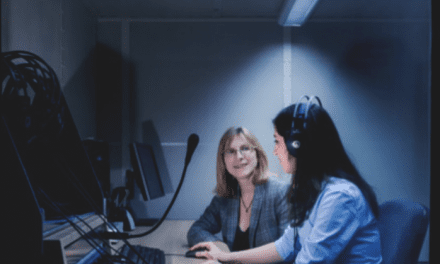Sonovation develops a full spectrum of hearing technologies for hearing-challenged individuals of all ages.

Sonovation, which has since become a subsidiary of AVR Communications in Israel, was established in Eden Prairie, Minn, for the research, development, and commercialization of hearing technologies for the severe-to-profound hearing-impaired population. Research and development are conducted at the Minnesota facility, while the manufacturing of products is done mainly in Israel.
The company, which has about 50 employees between the Minnesota and Israel sites, distributes its products to dispensing audiologists, hearing aid dispensers, clinics, and other dispensing professionals. The company is in the process of putting together schedules for training workshops to teach dispensers about its technologies.
“The founders of the company were reviewing the literature regarding hearing loss and hearing aids, and found that the severe-to-profound market was really underserved, and that traditional attempts at amplifying—just making things louder—were not going to achieve the speech understanding that people with significant hearing loss required,” says Wendy Davis, director of professional services, audiologist, MSCCCA.
Areas of Focus
When it began, the company focused on two areas: developing wireless communication to help the severe-to-profound hearing loss population overcome signal-to-noise issues—a technology that became what is now known as FM technology; and developing a technology that became frequency transposition, now known as frequency compression.
“The philosophy behind that technology is the voiceless speech sounds, which are so critical for speech intelligibility, that are located in the high frequencies. Most people with hearing loss, that’s where they have the poorest hearing,” Davis says. “The company initially took the pathways to develop some type of algorithm that could analyze the speech and then allow us as the clinician, the audiologist, to move those critical speech sounds into the lower frequency region, where people with hearing loss have better thresholds.”

Davis says Sonovation/AVR “shook up the industry” in 1991 when it introduced the first BTE/FM system, the Extend-Ear™.
“Prior to the inventions that came from Sonovation/AVR Communications, wireless FM was all-body devices, and that was very prohibitive for a lot of people wearing the technology. The developers at AVR Communications wanted to take that FM technology wireless—put it all ear-level—which was something very radical and very different,” she says.
Nowadays, the company’s primary push is on what is called digital frequency compression (DFC), which uses an algorithm to selectively move high frequency speech sounds to lower frequency regions where hearing is typically better.
“We’re the only company that’s doing this processing strategy. It is the only processing strategy that truly deals with a big topic in the industry, which is cochlear dead regions,” Davis says. “When you have cochlear dead regions, the research is saying that if you try to amplify the high frequencies, the signal becomes distorted, and so they’re cautioning audiologists about amplifying the high frequencies too much.
“Once you see hearing threshold levels get to 65 or 75 dB or poorer at 2,000 Hz and above, you have to be careful about amplifying significantly. The problem with that is all of the critical speech sounds for speech intelligibility are located at 2,000 Hz and above, so if you can’t amplify that, the patient is just losing these critical sounds, and you therefore cannot improve speech intelligibility. The digital frequency compression is a processing strategy that takes care of that,” she says.

DFC is available in a range of Sonovation/AVR products, including its Nano Xp, for infants and children, and Big Nano Xp, for adults. Those products have a sophisticated regular hearing aid platform with 17-band, nine-channel, open platform digital signal processing (DSP); independent dynamic compression on all channels; and flexibility; and come with or without directional microphones—all with the added feature of DFC.
“You can fit the hearing aids like very high-end digitals, and if your client is not performing as well as you’d like when it comes to speech, then it’s a click of a button on the fitting software and you can add this digital frequency compression,” Davis says. “The nice thing about this technology is that you can almost use your client as their own control: Fit the hearing aid without frequency compression, see how they do, and then fit it with the digital frequency compression, and see how they do.”
Sonovation/AVR also created Logicom Xp, another BTE/FM system that uses DSP to constantly monitor the strength of the radio signal to provide optimal FM reception and reduce noise from interference.
“It’s a hearing aid that runs this same sophisticated platform—the 17-band, nine-channel, open platform DSP—and then inside the hearing aid case is an FM receiver, so there’s no FM boot to attach to get lost, and then you also have the added benefit of the digital frequency compression,” Davis says. “From the standpoint of a hearing aid, it really is a total package.”
The company also creates custom products through its ImpaCt Xp software-driven DSP.
Serving a Broad Clientele
While Sonovation/AVR initially focused on adults in the severe-to-profound hearing loss population, its wireless technologies and frequency compression capabilities became very useful for pediatric clients, as well.

“The initial goals were FM systems and technologies for adults, but as we know, children’s needs—their language needs, their speech needs—far exceed what an adult who has a progressive hearing loss would have,” Davis says. “For those children who truly could not hear sounds like the ‘s’ as in ‘Sam,’ the ‘f’ as in ‘Frank,’ the ‘t’ as in ‘Tom,’ the voiceless ‘th,’ the frequency transposition/frequency compression lets these children hear these sounds for the first time, and we saw immediate improvement in reading skills and immediate improvement in speech production of school-age children because while you can learn to make these sounds if you can’t hear them, your entire system of communication is compromised if you don’t actually hear the sounds. It’s a way to give children these critical speech sounds, and give it to them in an area where their hearing is the best.
“With this philosophy, you’re not trying to drive significantly damaged receptors—damaged hair cells—in the higher frequencies to respond and possibly introduce distortion into the system. We’re going to use the most viable hair cells to recode these high-frequency speech sounds,” Davis says.
With the creation of such technologies, the severe-to-profound hearing loss population is perhaps no longer the underserved group they once were.
“Our technology is no longer just for the severe-to-profound. We can fit any kind of hearing loss now,” she says. “I think the severe-to-profound probably have more options than a lot of other people. Our technology really helps them, and I think that the general acceptance of cochlear implants has given the severe-to-profound opportunities that they didn’t have.
“I think that the underserved group now is the group that has fairly decent hearing in the low frequencies, and has very poor hearing in the high frequencies. I think they’re underserved because most technologies are just going to try to amplify, and if the hearing isn’t usable in those high frequencies or you can’t get the speech sounds audible because the speech sounds have very high frequency energy that typically spreads up through 10,000 Hz, these people are not being given the opportunity to have the complete picture of speech; they’re only getting certain portions of it,” Davis says.
Beyond the Basics
That is where Sonovation/AVR’s hearing technologies come in. Davis says that while the company does “the basics,” such as hearing aids, its staff likes to “think outside the box.” The company will continue in such areas as its algorithm and frequency compression developments.

Davis says that while some companies get too caught up in how a hearing aid functions, Sonovation/AVR, which she calls “a small fish in a big sea with big whales,” will continue to address the needs of those with hearing loss.
“We’ve always stayed on course,” Davis says. “We believe in this element of understanding the hearing, but understanding the speech is paramount to success.
“We always have a lot of things in the pipeline. We’re usually 10 to 15 years ahead of any of the other companies. Much like when Sonovation/AVR introduced the BTE FM many years ago, it took a lot of other organizations years to develop it and adopt it, and now FM is thought of as part of everyday life,” she says.
“With the frequency compression, there are thousands and thousands of users out there, and a lot of clinicians fitting it, but we still seem to be the only guy that really is addressing the two primary issues: the dead regions and the speech. We’ll continue to refine and develop that and lots of other things that are being looked at and worked on,” Davis says. “We think that there will be some pretty radical changes in the industry in the next 5 or so years. This issue of open platform DSPs, we think, is something that the industry is going to be forced to accept.”
Danielle Cohen is associate editor of Hearing Products Report.





